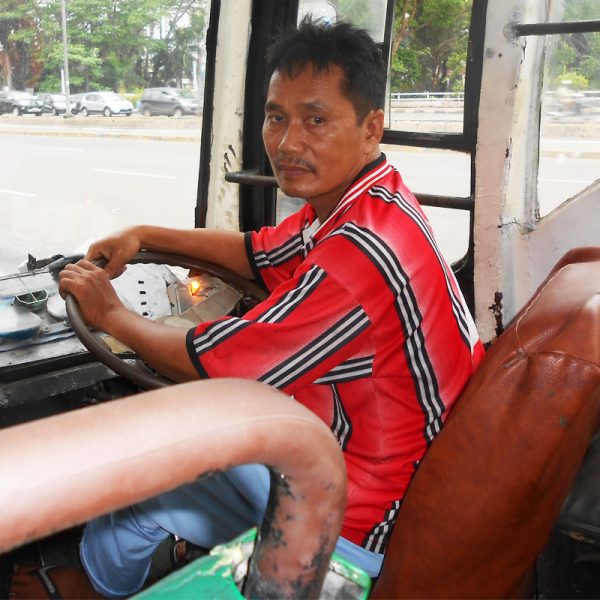
It’s a lazy Sunday afternoon along Jalan Sudirman, and Abdul Kodir is taking his time. Abdul is sitting in the driver’s seat of his Kopaja, leafing through a secondhand newspaper. The engine is off, but the keys are dangling in the ignition. Abdul’s not so much scanning the headlines as he is doing something with his hands. The smell of rain is everywhere, the April sky is turning black and ready to burst.
Abdul, who has been driving the 19 Route along Sudirman to Blok M for more than eight years, has parked his bus right outside the Dukuh Atas station along the Ciliwung and is biding his time until the train comes. He picks a bit of dirt out from underneath a fingernail with his thumb and cranes his neck to look out the windscreen and up into the sky, silently guessing when the sky is going to open up.
“Sundays are like this,” he says with a bit of reverie in his voice. “On Sundays I like to sit here at Dukuh Atas and wait for the train to come in. It’s a nice break from the weekdays when we get busy. This bus is full every other day of the week. Actually, the only time this bus isn’t full is when we sit here on Sundays.”
Anyone who has spent more than 10 minutes in Jakarta knows exactly what Abdul is talking about; Kopajas are notoriously crowded. During rush hour it’s common to see a jaw-dropping 60 people squeezed on to a bus meant to seat 25.
But the overcrowding doesn’t stop commuters. People would rather pack in a Kopaja like sardines than stand on the side of the road staring at their feet. And the rules of squeezing in wherever you can apply to everyone. Abdul insists that bules take a ‘when in Rome’ approach to riding on his Kopaja. “We have plenty of bule that ride the 19 route,” he says pointing down the road for emphasis. “Kopaja is the quickest way to get from one point to the other. People know that, so it doesn’t matter what colour your skin is, you go with whatever is fastest.”
Meanwhile, what might be the swiftest form of public transport – and at Rp.3,000, arguably the cheapest – might also be the most inconsiderate and boorish. Kopaja buses are notorious for stopping in the middle of the road to pick up passengers, or switching three lanes of traffic for reasons most motorists would agree are not only unsafe, but also simply asinine.
“What are we supposed to do? We have to pick people up,” explains Abdul. “If we don’t pick them up, then who will? Plus, that’s the reason people take Kopaja. We pick you up and drop you off wherever you want.”
Door-to-door service at the demise of everyone else. Blindingly barbaric, but it makes the idea of standing in line for TransJakarta or dropping the extra coin on a Blue Bird taxi contemptible. Almost like you are being taken for a ride.
However, still, there are the notoriously unnerving wives’ tales about lifted wallets, ransacked purses and pickpocketed handphones. Abdul shakes off the suggestion, earmarking it as persistent anti-kopaja canard. “That doesn’t happen on Kopaja,” Abdul says flatly. “You know how people like to chit-chat. We all know that. People like to create stories and talk about danger. All those stories where someone has something stolen involve someone’s uncle or aunt. It never happens to them.”
The next time you have a chance, please jump on a Kopaja. Just don’t steal anyone’s wallet, please.




